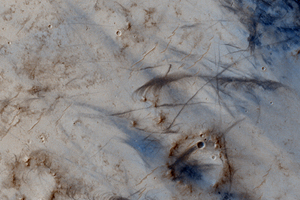
|
Dust-Devil Tracks in Southern Schiaparelli Basin
- Click the image above for a larger view
- Full-Res JPEG (2048 x 5861) (617.1 kB)
- Full-Res TIFF (2048 x 5861) (12.0 MB)
Caption:

Click on image for larger version
This HiRISE image PSP_006477_1745 of dust-devils are vortices of wind that form when air rising from a warm surface encounters shear in the above atmosphere. Martian dust devils can attain gargantuan proportions, reaching the size of terrestrial tornadoes with plumes that tower up to 9 kilometers above the surface. Dust-devils play an important role in sustaining the aerosols that make up Mars' red sky and in cleaning the Martian surface after a dust storm.
This observation shows a region near the Martian equator that is perfect tablet for the scribblings of dust-devils . This region is made up of dark bedrock that is thinly blanketed by bright dust. Dark tracks form when dust-devils scour the surface, exposing the darker substrate. The tracks tend to cluster together, as dust-devils repeatedly form over terrain that has been previously scoured and is consequently darker and warmer than the surrounding surface.
Once lofted by a dust-devil, the fine dust can be transported great distances before it settles again onto the surface.
Observation Toolbox
Acquisition date:
14 December 2007
Local Mars time:
2:25 PM
Degrees latitude (centered):
-5.2°
Degrees longitude (East):
17.7°
Range to target site:
264.7 km (165.4 miles)
Original image scale range:
26.5 cm/pixel(with 1 x 1 binning) so objects ~79 cm across are resolved
Map-projected scale:
25 cm/pixel and north is up
Map-projection:
EQUIRECTANGULAR
Emission angle:
0.1°
Phase angle:
36.8°
Solar incidence angle:
37°, with the Sun about 53° above the horizon
Solar longitude:
2.2°, Northern Spring
For non-projected projected products
North azimuth:
97°
Sub-solar azimuth:
14°
For map projected products:
North azimuth:
207°
Sub-solar azimuth:
188.638°
Background Info:
NASA's Jet Propulsion Laboratory, a division of the California Institute of Technology in Pasadena, manages the Mars Reconnaissance Orbiter for NASA's Science Mission Directorate, Washington. Lockheed Martin Space Systems, Denver, is the prime contractor for the project and built the spacecraft. The High Resolution Imaging Science Experiment is operated by the University of Arizona, Tucson, and the instrument was built by Ball Aerospace and Technology Corp., Boulder, Colo.
Cataloging Keywords:
| Name | Value | Additional Values |
|---|---|---|
| Target | Mars | |
| System | ||
| Target Type | Planet | |
| Mission | Mars Reconnaissance Orbiter (MRO) | |
| Instrument Host | Mars Reconnaissance Orbiter | |
| Host Type | Orbiter | |
| Instrument | High Resolution Imaging Science Experiment (HiRISE) | |
| Detector | ||
| Extra Keywords | Atmosphere, Color, Dust, Infrared, Map, Plume, Storm | |
| Acquisition Date | ||
| Release Date | 2008-01-24 | |
| Date in Caption | 2007-12-14 | |
| Image Credit | NASA/JPL/Univ. of Arizona | |
| Source | photojournal.jpl.nasa.gov/catalog/PIA10226 | |
| Identifier | PIA10226 | |
